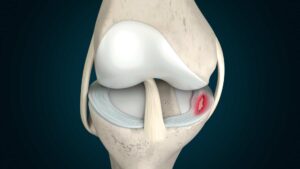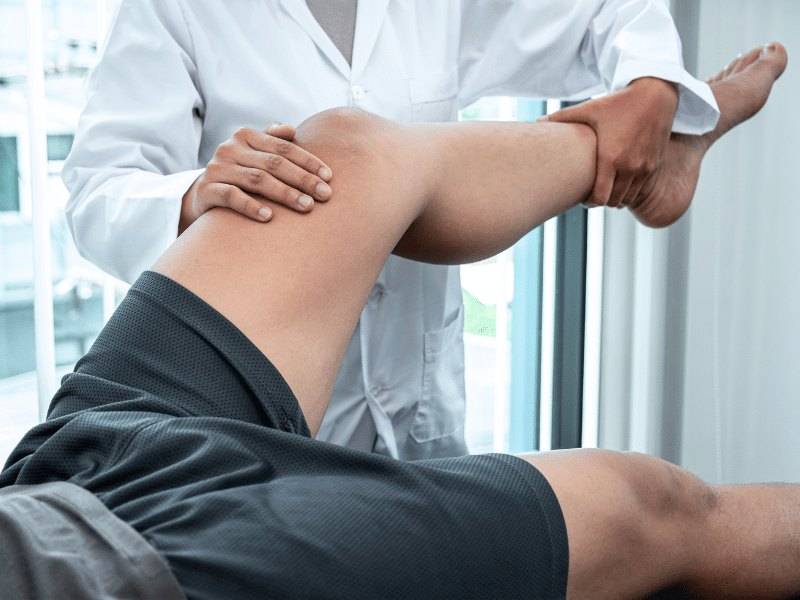If you are one of the many people who suffer from a meniscal tear, you know how debilitating it can be. You may have difficulty walking, climbing stairs, or even squatting down. This is because the meniscus is responsible for cushioning the knee joint and providing stability. If you have torn your meniscus, don’t worry – there is hope! In this blog post, we will discuss how to rehabilitate a meniscal tear using various methods including physical therapy, exercise, and surgery.
Contents
What Is Meniscal Tear?
 A meniscal tear is a common knee injury. The meniscus is a crescent-shaped piece of cartilage that acts as a shock absorber between your femur (thighbone) and tibia (shinbone). A meniscal tear may occur due to a sudden twisting motion when the knee is bearing weight. The most common symptoms of meniscal tear are pain and swelling.
A meniscal tear is a common knee injury. The meniscus is a crescent-shaped piece of cartilage that acts as a shock absorber between your femur (thighbone) and tibia (shinbone). A meniscal tear may occur due to a sudden twisting motion when the knee is bearing weight. The most common symptoms of meniscal tear are pain and swelling.
This condition is often seen in athletes, especially those participating in contact sports. Meniscal tears can also occur due to degenerative changes related to aging.
There are two types of meniscal tears:
- Acute tear: This is a sudden, traumatic injury that usually occurs during sports or other physical activities. The symptoms of an acute tear include severe pain, swelling, and limited range of motion.
- Degenerative tear: This type of tear is caused by the wear and tear of the cartilage over time. The symptoms of a degenerative tear are usually less severe than those of an acute tear and may include knee pain and stiffness.
If you have a meniscal tear, it is important to see a doctor for an accurate diagnosis. Your doctor will likely order imaging tests, such as an MRI, to confirm the diagnosis.
Can You Rehab A Meniscus Tear?
Yes, meniscal tear rehabilitation is possible. Because the tear is on the cartilage that cushions your knee, it’s important to give it time to heal properly. Depending on the size and location of your tear, your doctor may recommend physical therapy or surgery.
If you have a small tear, you may not need any treatment other than RICE (rest, ice, compression, elevation) and over-the-counter pain relievers. But if your tear is more severe, you may need physical therapy to help strengthen the muscles around your knee and improve your range of motion. Surgery may also be necessary to repair the tear.
No matter what treatment you receive, it’s important to follow your doctor’s instructions and take things slowly. With an accurate treatment, meniscal tear rehabilitation is possible and you can expect to make a full recovery.
What Treatments Are Used In Meniscal Tear Rehabilitation?
 There are several different types of treatments that can be used in meniscal tear rehabilitation. Some of the common treatment options include:
There are several different types of treatments that can be used in meniscal tear rehabilitation. Some of the common treatment options include:
Physical therapy
Physical therapy can help to improve the range of motion in the knee and strengthen the muscles around the joint. This can help to prevent further injury to the meniscus. It is believed that physical therapy can also help to speed up the healing process. There are various types of physical therapy exercises that can be used in meniscal tear rehabilitation. These include:
- Quadriceps strengthening exercises: These exercises help to strengthen the muscles around the knee joint.
- Hamstring stretching exercises: In this type of exercise, the hamstrings are stretched in order to increase the range of motion in the knee.
- Aerobic exercises: These exercises help to improve the blood circulation around the knee joint and also help to speed up the healing process.
- Weightbearing exercises: These exercises help to put weight on the injured meniscus and help it to heal.
Medicines
There is no one-size-fits-all answer to the question of whether or not you should take medication for a meniscal tear, as the decision will depend on your individual circumstances. However, over-the-counter pain relievers such as ibuprofen and acetaminophen can be helpful in managing pain and inflammation associated with a meniscal tear. If your pain is severe, your doctor may prescribe a stronger medication.
RICE method
A tear in the meniscus is a common knee injury. The best way to treat a meniscal tear is the RICE method:
- Rest: Avoid activities that put stress on your knees, such as running or jumping.
- Ice: Apply ice to your knee for 20 minutes at a time, several times a day.
- Compression: Use a compression bandage to help reduce swelling.
- Elevation: Keep your knee elevated above the level of your heart to reduce swelling.
This is believed to help reduce pain and swelling in the knee.
Manual therapy
It is always best to start with manual therapy when treating a meniscal tear. This will help to control the pain and inflammation while also allowing the knee to begin moving again. It works by breaking up the scar tissue that has formed around the tear, which can help to improve the range of motion in the knee.
For example, one type of manual therapy that can be used is called “joint mobilization.” This is where the therapist will use their hands to move the knee joint around in different ways. This helps to loosen up the scar tissue and also increases the range of motion in the knee.
Strengthing exercise
 As a meniscal tear is caused by the overuse of the knee joint, it is very important to do some strengthening exercises to prevent the injury from happening again.
As a meniscal tear is caused by the overuse of the knee joint, it is very important to do some strengthening exercises to prevent the injury from happening again.
There are many different ways to do the exercises, but one effective way is by using an elastic band. By looping the band around your foot and anchoring it to a sturdy object, you can do a variety of exercises to work the muscles around your knee.
Some effective exercises include:
- Leg extensions: Sit on the floor with your leg straight in front of you and the band looped around your foot. Slowly raise your leg up, keeping your thigh muscle tight. Hold for a count of two, then lower back down. Do two sets of 10.
- Leg curls: Lie on your stomach with your leg straight behind you and the band looped around your foot. Slowly curl your leg up, keeping your thigh muscle tight. Hold for a count of two, then lower back down. Do two sets of 10.
- Lateral leg raises: Lie on your side with your legs straight and the band looped around both feet. Slowly raise your top leg up, keeping your thigh muscle tight. Hold for a count of two, then lower back down. Do two sets of 10.
Surgery
In some cases, surgery may be necessary to repair a meniscal tear. Your doctor will determine if surgery is necessary based on the size and location of the tear, as well as your age and activity level.
After surgery, you will likely need to participate in physical therapy to help you regain range of motion and strength in your knee. Physical therapy may last for several weeks or months. Your doctor may also recommend that you use crutches for a period of time after surgery to keep weight off your knee as it heals.
Overall, these are just a few considerations for meniscal tear rehabilitation. Talk to your doctor to develop a personalized treatment plan that is right for you.
What Are The Goals Of Meniscal Tear Rehabilitation?
 When you have a torn meniscus, the goals of rehabilitation are to:
When you have a torn meniscus, the goals of rehabilitation are to:
- Relieve pain
- Reduce swelling
- Restore full range of motion
- Strengthen the muscles around the knee
- Improve your ability to function and participate in activities
These goals may be accomplished through a combination of activity modification, physical therapy, and exercises. It is important to have realistic expectations. The amount of time it takes to recover from a meniscal tear and return to your previous level of activity depends on many factors, such as the type of injury, your age, and your overall health.
In addition, there are three main stages of meniscal tear rehabilitation:
- Stage 1: Relief from pain and swelling
- Stage 2: Restoring range of motion and flexibility
- Stage 3: Gradually returning to normal activities
So you can see that there are different things to focus on at each stage of rehabilitation. It is important to progress through these stages as tolerated, without pushing too hard and risking further injury.
What Is The Best Way To Rehab A Torn Meniscus?
Now, many people will assume that they need surgery when they experience a torn meniscus. However, this is not always the case. With the right rehabilitation exercises, you can often heal a torn meniscus without ever going under the knife.
Here are some of the best exercises for rehabbing a torn meniscus:
Heel Slides
 This is a great exercise for helping to reduce pain and swelling in the knee joint. To do this exercise, simply sit on the floor with your legs extended straight out in front of you. Place a small towel under your affected knee. Slowly slide your heel towards your butt, stopping when you feel a stretch in your knee. Hold this position for 15-30 seconds before returning to the starting position. Repeat this exercise 10 times.
This is a great exercise for helping to reduce pain and swelling in the knee joint. To do this exercise, simply sit on the floor with your legs extended straight out in front of you. Place a small towel under your affected knee. Slowly slide your heel towards your butt, stopping when you feel a stretch in your knee. Hold this position for 15-30 seconds before returning to the starting position. Repeat this exercise 10 times.
Hamstring Curls
 This exercise is great for strengthening the muscles around the knee joint, which can help to stabilize the joint and reduce your risk of further injury. To do this exercise – lie on your back with your legs straight and a towel wrapped around the ankle of the affected leg. Use your hamstring to curl the towel towards your glutes, keeping your leg straight. Return to the starting position and repeat for 10-15 repetitions. Complete 2-3 sets of this exercise.
This exercise is great for strengthening the muscles around the knee joint, which can help to stabilize the joint and reduce your risk of further injury. To do this exercise – lie on your back with your legs straight and a towel wrapped around the ankle of the affected leg. Use your hamstring to curl the towel towards your glutes, keeping your leg straight. Return to the starting position and repeat for 10-15 repetitions. Complete 2-3 sets of this exercise.
Leg Lifts
 This exercise is effective for strengthening the quadriceps, which are the muscles in the front of the thigh. Strong quads can help to take pressure off of the knee joint and reduce your risk of further injury. To do this exercise – lie on your back with both knees bent and your feet flat on the floor. Slowly lift one leg straight up into the air, keeping your thigh muscle tight. Hold for a count of two, then lower back down to the starting position. Repeat 10-15 times with each leg.
This exercise is effective for strengthening the quadriceps, which are the muscles in the front of the thigh. Strong quads can help to take pressure off of the knee joint and reduce your risk of further injury. To do this exercise – lie on your back with both knees bent and your feet flat on the floor. Slowly lift one leg straight up into the air, keeping your thigh muscle tight. Hold for a count of two, then lower back down to the starting position. Repeat 10-15 times with each leg.
Mini squats
It is important to keep the weight on your heels when doing mini squats. You can do this by placing a towel under your feet before you start. Slowly lower yourself down, as if you are going to sit in a chair. Go down until your thighs are parallel to the floor, and then raise yourself back up. Repeat this 10 times.
Heel Dig Bridging
 Finally, you will need to do some heel dig bridging. This is a great way to rebuild the meniscus and avoid future tears. To do this, you will need a partner. Lie on your back with your legs extended. Your partner will then grab your ankles and pull them toward your chest. You should feel a stretch in your hamstrings. Once you feel the stretch, slowly raise your hips off the ground and hold for two seconds. Lower your hips back to the ground and repeat. Do three sets of ten reps.
Finally, you will need to do some heel dig bridging. This is a great way to rebuild the meniscus and avoid future tears. To do this, you will need a partner. Lie on your back with your legs extended. Your partner will then grab your ankles and pull them toward your chest. You should feel a stretch in your hamstrings. Once you feel the stretch, slowly raise your hips off the ground and hold for two seconds. Lower your hips back to the ground and repeat. Do three sets of ten reps.
If you have a meniscal tear, don’t despair. With the right rehabilitation exercises, you can heal your injury and get back to your normal activities. Just be sure to consult with a doctor or physical therapist before starting any rehabilitation program.
Can It Be Prevented?
A meniscal tear cannot always be prevented. However, you can lower your risk by:
- Maintaining a healthy weight
- Avoiding high-impact activities
- Participating in regular exercise to strengthen the muscles around your knee joint
If you do experience a meniscal tear, early diagnosis and treatment are essential for proper healing. Depending on the severity of your injury, your doctor may recommend a combination of the treatments discussed above.
Overall, most people can easily prevent meniscal tears or heal fully from them with the proper medical care. However, if you ignore your injury or try to tough it out, you could end up doing more damage to your knee joint. So, if you think you may have torn your meniscus, be sure to see a doctor right away.
Conclusion
In a nutshell, a meniscal tear rehabilitation can be a difficult and long process. It is important to consult with a physician or certified physical therapist to create a personalized rehabilitation program. With the proper guidance and care, full recovery is possible and you can return to your prior level of activity.
Physical Therapy has always been proven to help patients recover from pain. Hence, if you’re experiencing Back pain, Shoulder pain, Knee pain, Neck pain, Elbow pain, Hip pain, or Arthritis pain, a physical therapist at MantraCare can help: Book a physiotherapy session.


